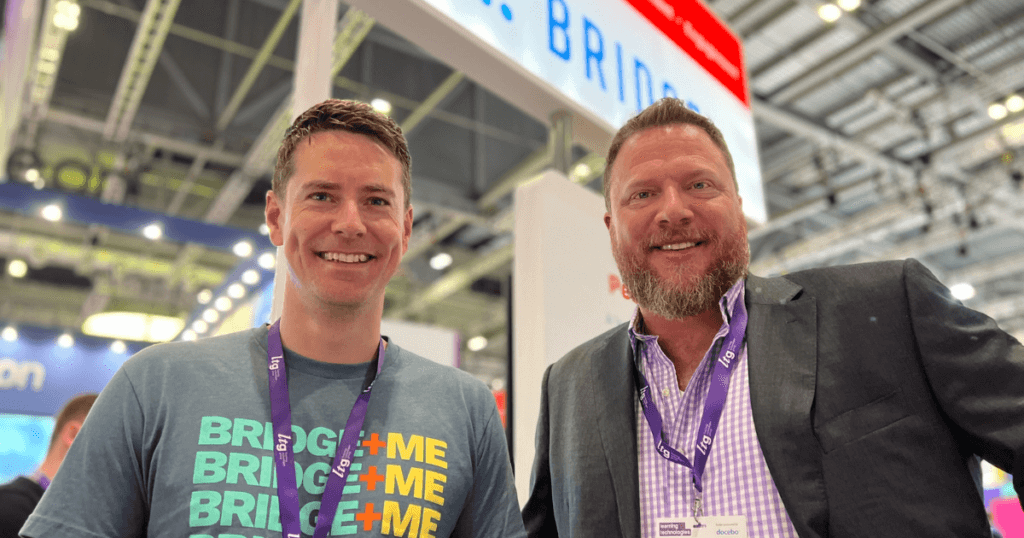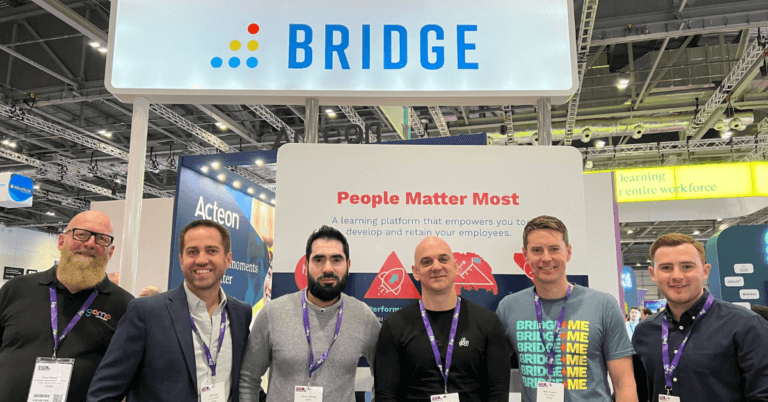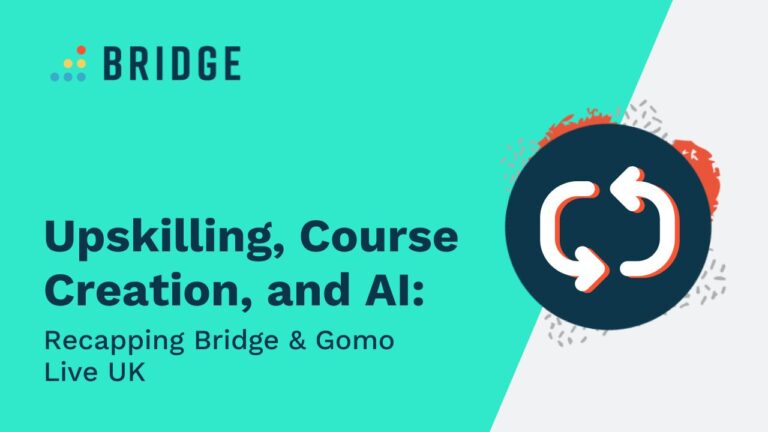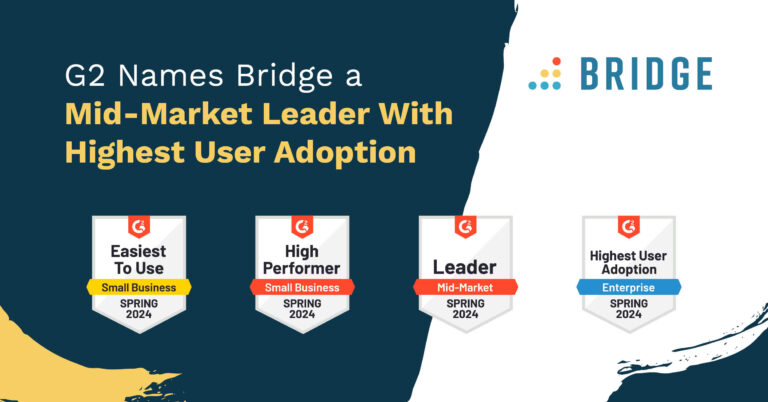After a two-year hiatus, the Learning Technologies conference and expo was back as a face-to-face event, and opportunities to network in person were enthusiastically embraced by all attendees. With more than 9,000 visitors and 200 exhibitors, Europe’s largest learning conference delivered a wealth of fresh insights into the rapidly evolving world of workplace learning and development.
Here’s our roundup, mainly from the conference, of the top trends and the latest thinking on hot topics, including hybrid working, diversity, and reskilling for the future.
1. The Growing Need for Cognitive Diversity
Author and columnist Matthew Syed kicked off day one on a high, exploring the role of diversity in a growth mindset. He highlighted the importance of such mindsets, as organizations that experience success can run the risk of becoming complacent and exist in a fixed mindset. The danger is that this can stifle creativity and impact the hiring process. A company that surrounds itself with like-minded people will stop innovating, he warned. For organizations to be high-performing, they need to nurture a diversity of thinking within a culture of growth. This growth allows them to innovate, think differently, and explore new ideas to improve. Cognitive diversity is central to the learning culture, as a diverse team brings a fresh perspective.
It’s not enough to just hire talented people, as they won’t drive innovation. Instead, hire people who can bring different perspectives and ideas to your company and give them the opportunities to develop their skills.
2. Hybrid Working Is Driving a Shift In Learning and Development
Hybrid working is fuelling a new approach to learning and development. As highlighted by Fosway, 48% of L&D professionals have adapted their approach to support the hybrid workforce, and 56% believe that the pandemic accelerated their approach to skills.
As this new way of working becomes the norm, it’s vital to have a strategy for redefining your organization’s learning culture. Introducing technology such as social and collaborative learning opportunities, nudges, and personalization are part of a package of measures you can take to support your digital learners.
YOU MIGHT ALSO LIKE | ‘4 Ways to Personalize the Learning Journey’
3. Virtual Reality for Relatable, Memorable Learning
While virtual reality isn’t a new concept, the growing adoption of immersive tech coupled with the need for L&D brings the possibility for a new kind of engaging, authentic, and targeted learning. Mark Story, Head of Learning Innovations at Newcross Healthcare Solutions shared his account of designing narrative-led learning to replace lectures. By creating immersive mini-stories, relatable characters, and sector-specific outcomes that learners would face in their roles, VR added a new dimension to increase emotional engagement and learning retention.
As technologies advance, this also calls into question how immersive these stories could become. The adoption of the Metaverse means a chance to deliver learning and development in an even more immersive way to connect with learners in the future.
4. The Rise of User-Generated Content
Digital learning is on the up. Fosway’s David Wilson and David Perring discussed how, in 2023, we can expect more organizations to increase their investment in user-generated content and decrease the use of pre-made and custom-created materials. This is reflective of the creator economy, with platforms like TikTok and Instagram being leveraged more.
With more people using these platforms as part of their everyday media consumption, there’s a growing opportunity for informal learning that makes good use of the creative possibilities and the limited runtime of the videos to produce engaging, bite-sized learning experiences for users.
CAPTURE, CREATE, AND CATALOG KNOWLEDGE | ‘Bridge Advanced Video’
5. The Advance In Automation Has Highlighted a Skills Gap
Day two of LT opened with a forecast into the future of work, skills, and technology by Marco Dondi, Associate Partner at Mckinsey, Anita Lettink, Partner at the Strategic Management Centre, and author Julia Hobsbawm. In 2022, we’re already seeing a rise in automation for manual and low-tech work, but the future will also see the automation of knowledge work. This means that there’s a growing need to teach people how to work with robots.
The increased tech transformation is changing jobs. They identified 56 elements of talent (or DELTAs) to thrive in a future which is shifting to cognitive, interpersonal, leadership, and digital competencies. Employers should look to develop skills like communication, teamwork, and mental flexibility for future success. Dondi emphasized that education institutions aren’t currently training people well in these skills, so employers need to give their people the chance to learn and develop in the workplace.
RECOMMENDED READING | ‘Tackling the Skills Gap: Could Soft Skills Be the Answer?’
6. Organizations Are Putting People First
One of the biggest takeaways from Lightsource and BT’s conference session was the importance of change in being up to date with the latest trends. For successful change, you need to involve learners in the process, put them at the center of what you do, and communicate with them frequently. Learning has to be personal because if they aren’t buying into the changes you’re making or the opportunities you’re offering, nothing will change. Being people-centered means employees feel empowered and engaged, and they’ll become the strongest advocates for the direction you want them to take. You need to pull learners into the design process, have them involved upfront, and share the problems and solutions with them. The earlier you listen to the valuable feedback that they can offer you, the more likely you are to meet their needs.
President of Bridge, Peter Brussard, and our VP of Sales, Mark Probert, also took to the exhibition stage during the event to present their insights on how to drive employee happiness with a people-centric approach. During their seminar, they emphasized the need for meaningful, regular conversations, why personalized learning and development matters, and the importance of connecting with people.

7. AI Is Making Learning More Personal
Technology can help companies make more empathetic decisions and connect with their people in new ways. There’s a growing trend in AI to help with coaching and training needs. Technology can personalize the questions employees are asked to make these conversations more relevant, provide insights into behaviors, assign training where necessary, and match up employees with the managers who can best meet their needs. We’re also seeing AI being leveraged to deliver more targeted learning where user matching provides the content that learners need to know when they need to know it.
8. Learning in the Flow of Work and Credentials
Your employees are busy—this isn’t a new idea! But what might be new is the opportunity for them to learn in the flow of work through platforms they’re already using. Instead of learning being a fixed set of activities that take time away from the workday, the emphasis is on offering microlearning to support a moment of need. Doing this allows your learners to become more self-sufficient and means less disruption. That self-sufficiency will lead to an increase in self-directed learning, which will truly be putting the user at the center of their own learning experiences.
There’s also an emergence of microcredentials in the workflow, which means that employees can gain qualifications and be recognized for them with minimal disruption. These credentials are tied to self-issued badges as a way to showcase their skills.
MORE FROM THE BLOG | ‘What Is Microlearning?’
9. Accessibility in eLearning
There’s an increasing need to ensure employees have equitable access to learning, as commitment to diversity, equity, and inclusion is growing. In 2022, 55% of L&D owns or shares responsibility for DE&I, compared to 40% in 2021 (according to LinkedIn Workplace Learning Report 2021 and 2022).
As part of this need, Susi Miller, eLearning accessibility expert, explored how digital accessibility is increasingly being integrated into learning materials. Visual, hearing, cognitive, and motor needs should all be considered when designing content to make it as user-friendly as possible. Factors such as transcripts, screen recorders, large text for videos, keyboard accessibility, simple language, and consistent navigation should be the norm.
Make Learning Part of Your Culture
Stepping away from the conference, what’s clear is the desire for the industry to adapt, innovate, and use learning and development as the driving force to overcome any challenges ahead. While these trends aren’t new, they do represent a reinforcement of our collective commitment for L&D teams to drive these issues forward and embed best practices.
To find out how to make learning part of your culture, how to attract and retain the best talent, and ways to close the skills gap, download the ebook ‘Learning to Adapt: How to Put Learning and Development at the Heart of Your Company’s Culture’.
Download the ebookFind a tool to connect with your workforce




